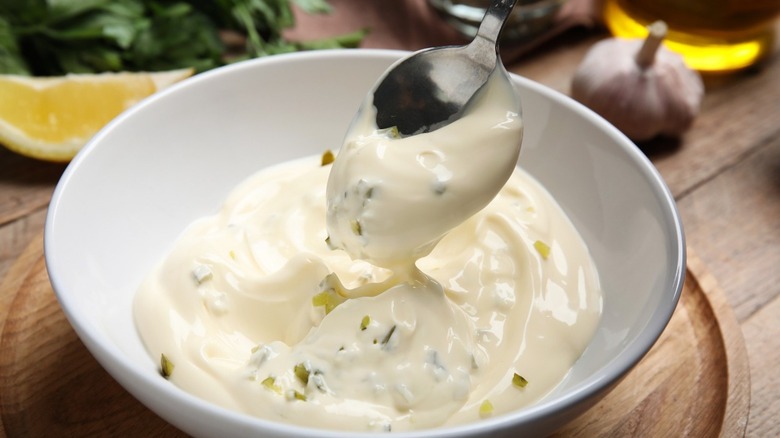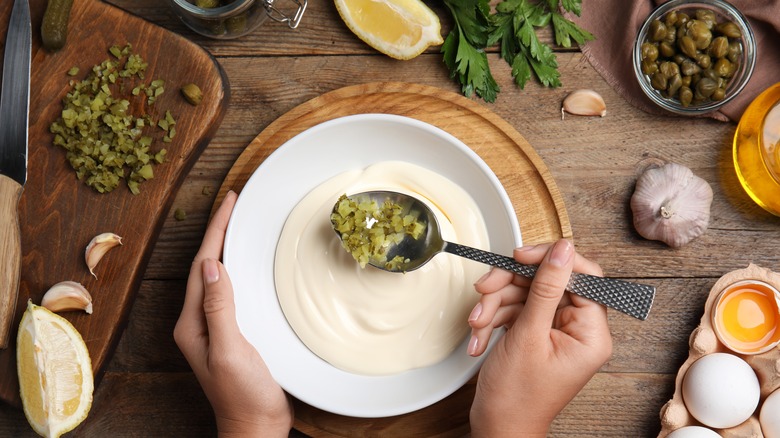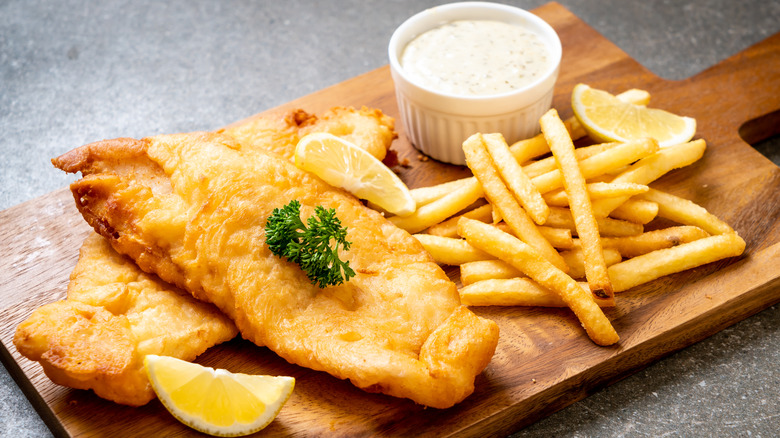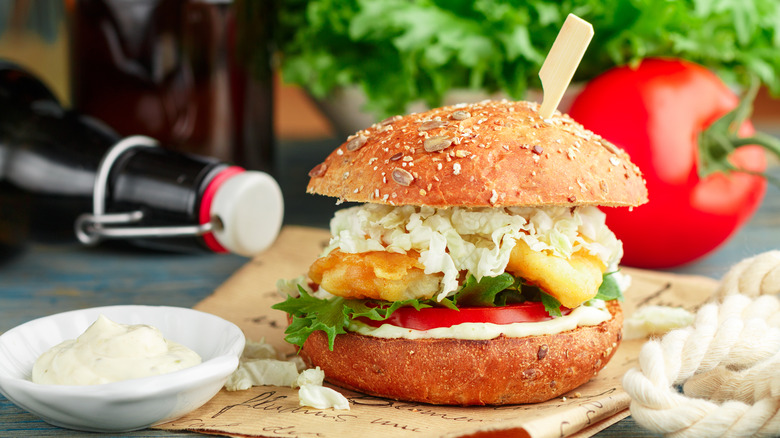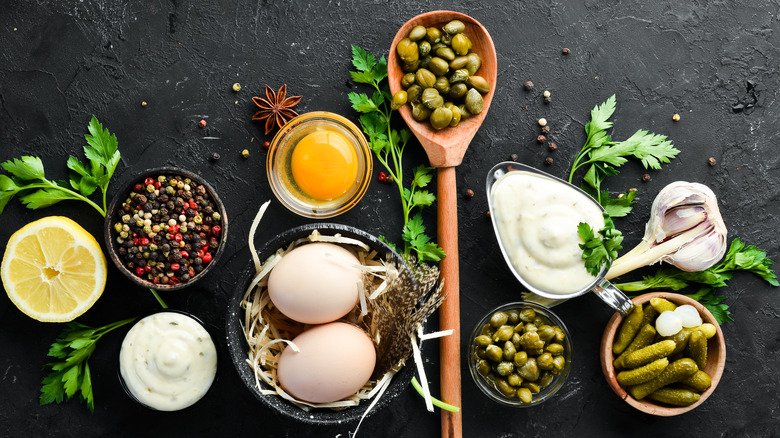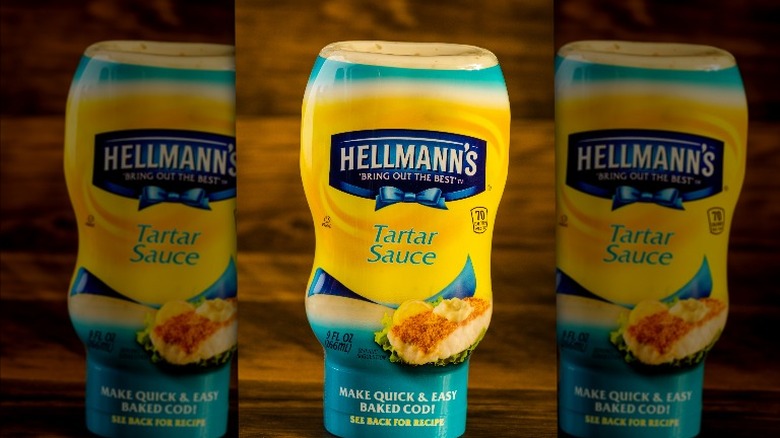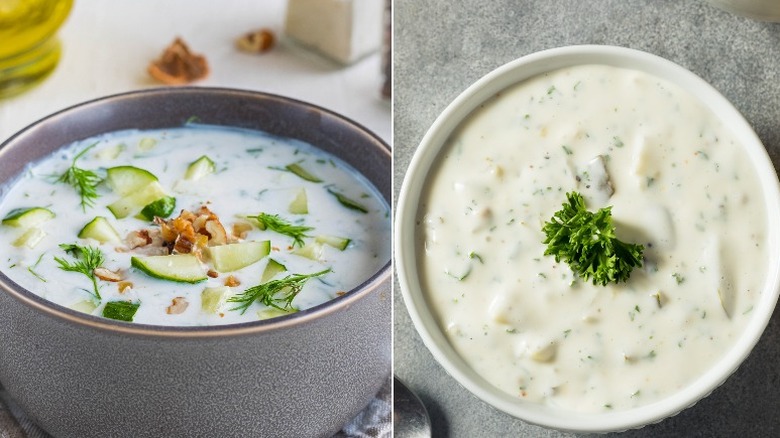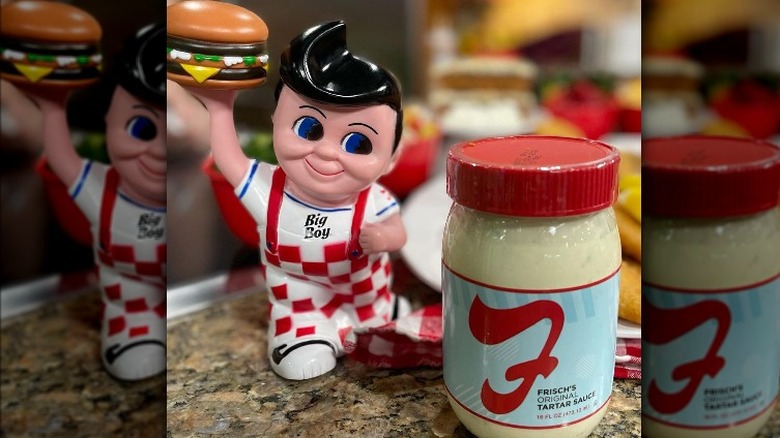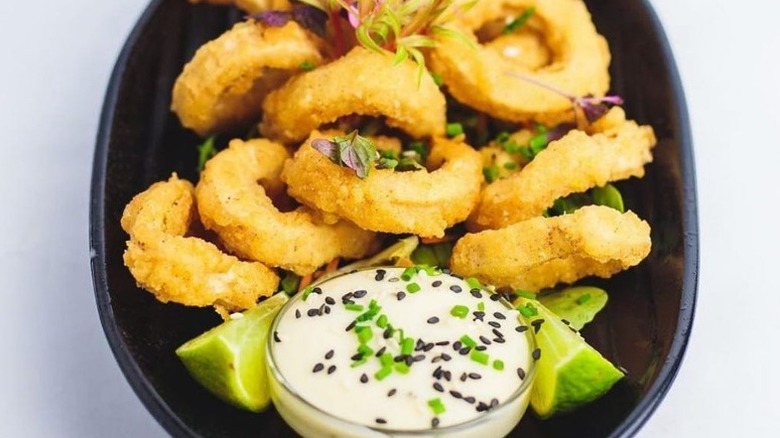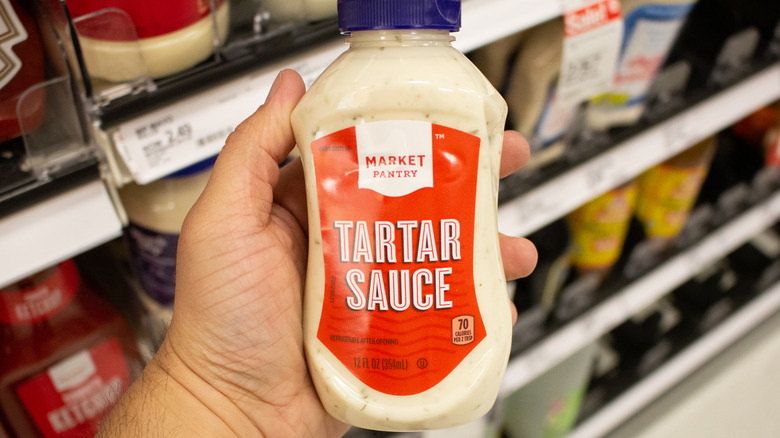14 Facts You Need To Know About Tartar Sauce
Peanut butter and jelly, chicken and waffles, chips and salsa: some pairings were meant to be. And while fried seafood and tartar sauce doesn't have the same name recognition, it's safe to say that our favorite fish dishes would suffer without some help from the creamy, tangy sauce we've all come to love. Made with mayonnaise, pickles, mustard, and lemon juice, tartar sauce is a chilled condiment popular throughout the world.
But there's so much more to this chunky off-white sauce than you might realize. In this article, we delve into need-to-know tartar sauce facts including recipe variations, unexpected uses, name origins, health benefits, and more. And by the time it's all said and done, we guarantee you'll never look at this tasty sauce the same way ever again. So, grab your mayonnaise, dig into your fish and chips, and get ready to learn about the fascinating life of tartar sauce.
1. There are more ingredients than meet the eye
When you're in a rush, you can whip up a quick four-ingredient tartar sauce by combining mayonnaise, chopped pickles (or relish), yellow mustard, and lemon juice. However, if you're looking for a more refined homemade tartar sauce, substitute the yellow mustard for Dijon and add ingredients like capers, cornichons, and Worcestershire sauce. The variations don't end there. For example, you can try using aioli instead of mayonnaise. This substitution results in a thinner sauce with strong notes of garlic. Alternatively, you can experiment with herbs. Tarragon and dill are classics but parsley, rosemary, and basil are also excellent for freshening up your sauce. If you're feeling hesitant about experimenting, just remember — it's really difficult to mess up tartar sauce.
True culinary rebels can mix things up by adding unconventional ingredients like green olives, jalapeños, or smashed avocado. Each of these ingredients creates a totally new tartar sauce experience. Green olives add an extra dose of saltiness that balances out the bready flavor of fried dishes, whereas jalapeño tartar sauce gives a spicy kick to fish tacos and fried catfish. On the other hand, avocado tartar sauce adds a pleasant creaminess to burgers or sandwiches.
2. It's the perfect seafood condiment
This one might seem like a no-brainer, especially if you've spent any amount of time gobbling up fried seafood. But have you ever wondered why tartar sauce pairs so well with your beloved fish and chips? There are a few reasons why it's so crave-worthy when eating seafood.
For one, the mayonnaise gives tartar sauce its distinctive body, perfect for clinging to breaded clams, oysters, and calamari. The mayo also provides a creaminess that softens the crunchiness of the fried crust and helps keep the fish or seafood moist, something that proves challenging when frying. Another reason tartar sauce and fried seafood go hand in hand is that the lemon juice provides just the right amount of acidity to balance out the richness and fishiness of the main dish. Lastly, the chill of the tartar sauce offsets the heat from the fryer, allowing you to cool down your food to the perfect chow-down temperature.
3. Many versions exist
While switching up ingredients here and there will give your tartar sauce a slightly different taste, the American version has a pretty consistent flavor profile. However, lots of other cuisines have their own version of tartar sauce well worth checking out. Not only will they shake up your taste buds, but they also complement their respective cuisines more than the standard American sauce.
The Japanese version (aka tarutaru sauce) is one of the biggest standouts. It features chopped hard-boiled eggs, an ingredient that gives even more heft and texture to an already chunky sauce. Another difference is the base. Whereas American tartar sauce uses whole-egg mayonnaise, the Japanese version uses Kewpie mayonnaise. Kewpie mayonnaise is made using just the egg yokes, resulting in a yellowy hue and richer flavor. It also contains rice vinegar for punchiness and monosodium glutamate for even more umami goodness. It's typically served with dishes like fried oysters, tonkatsu (fried pork cutlet), and fried shrimp.
4. It's more versatile than you think
You probably don't think twice about pairing tartar sauce with fried shrimp or fish. But this creamy, tangy sauce is more than just a seafood sidekick. Rather, its texture and flavor profile complements a variety of dishes. Other fried foods like chicken or wiener schnitzel are an obvious place to start, but don't limit yourself. For example, you can shake up your vegetable recipes by dipping air-fried cauliflower or baked veggies in tartar sauce. Along the same lines, substitute ranch dressing for tartar sauce when serving a crudité platter of raw vegetables and pita bread.
And the wonders don't stop there. Adding a dollop of tartar sauce to deviled eggs gives them next-level texture and flavor you won't believe. Tartar sauce also pairs seamlessly with potatoes. As an example, try adding a dollop on top of baked potatoes for a whole new flavor experience. Another option is to incorporate it when making potato salad. Simply substitute half the mayo for tartar sauce. It also makes for a unique spread on burgers, chicken sandwiches, and more.
5. Other countries use it differently
Although tartar sauce is mostly relegated to seafood dishes in the United States, other countries have branched out in their tartar sauce usage. For example, Japan and Australia serve fried chicken with tartar sauce, not ketchup or barbecue sauce. In the Czech Republic, tartar sauce (or tatarska omacka in Czech) is served alongside french fries and fried breaded cheese.
Spanish cuisine uses tartar sauce as an accompaniment to meat pudding (pudín de carne). Like its American cousin, meatloaf, pudín de carne uses minced beef, eggs, onions, and carrots to create a savory loaf. Spaniards also pair tartar sauce with salmon-stuffed lettuce, a cold starter perfect for the country's hot weather. But perhaps no country has innovated more with tartar sauce than the land of its birth — France. Starting in the 19th century, French chefs paired steak tartare with tartar sauce. Nowadays, they use it to finish off lamb burgers and pork cheek sandwiches.
6. Romans might have created the first tartar sauce
As is the case with many foods, the origin of tartar sauce is unclear. Citing French cookbooks from the 19th century, Julia Child contended that the sauce-happy French likely invented it to go with their beloved steak tartare. Others believe that the French merely modified an existing recipe. Indeed, certain historians theorize that like a lot of French sauces, tartar has its origins in an ancient Roman recipe.
From there, the recipe evolved throughout the Middle Ages and took its current form in France. More specifically, it's thought that the original recipe used a cream base, something the French substituted with mayo. Proof of this can be found in tartar sauce variations that use crème fraiche, a fatty sour cream popular in French cooking. It's certainly a compelling theory, but whether or not it's true remains a mystery. Either way, it seems pretty clear that the French are at least responsible for giving tartar sauce its name.
7. The name has a complicated history
The exact origins of tartar sauce are unclear but the etymology of the term is relatively easy to follow, despite being a bit complicated. Tartar sauce gets its name from the French term sauce tartare. Sauce tartare was originally served with steak tartare, a classic French dish made by combining raw minced beef (or horse meat) with capers, Worcestershire sauce, parsley, and pickled vegetables. The mixture is formed into a patty and topped with a raw egg. Modern versions don't usually come with tartar sauce, but it was a standby in earlier iterations of the dish.
Tartare is thought to derive its name from the Tatars (also spelled Tartars), a group of Turkic speakers from Eastern Europe and Central Asia known for their strength in battle. The term likely came to English via the Medieval Latin tartarum and from Tartaros, the underworld in Greek mythology. Given the Tartars' fighting skills, this name is apt. In addition to their strength, these nomadic horsemen had a reputation for eating raw chopped horsemeat. News of the dish spread to Europe via German sailors and led to the invention of hamburgers and eventually steak tartare.
8. Hellmann's reportedly made the first jarred tartar sauce
Tartar sauce was made from scratch for the first hundred or so years it was around. Luckily, this simple sauce wasn't too much of a burden on cooks, but that didn't mean food companies weren't looking for a way to make their customers' lives easier.
Hellmann's was likely the first major food manufacturer to provide consumers with ready-to-serve tartar sauce in the 1920s. It makes sense that one of the world's leading mayonnaise manufacturers would be at the forefront of the commercial tartar sauce game. The brand's tartar sauce had a nearly 100-year run, accumulating fans all over the world. However, many found themselves disappointed when Hellmann's discontinued its tartar sauce sometime in early 2022. Adding insult to injury, Hellmann's has not revealed why it stopped making its famous sauce, nor has the brand given any sign of bringing it back in the future.
9. There's no relation between tartar sauce, tarator, or cream of tartar
Although the three terms resemble each other, they don't have much in common. Tartar sauce, as we know, is a mayonnaise and pickle-based sauce often served with fried seafood dishes. Tarator has a few different meanings, depending on where you find yourself. In Levantine cuisine, tarator is a tahini-based sauce often paired with falafel or beef shawarma. In addition to tahini, it contains lemon juice, water, and salt. Nearby in Turkey, tarator is a walnut-based sauce made with breadcrumbs, garlic, olive oil, and lemon juice. Similar to tartar sauce, it's usually served with fried calamari. To add to the confusion, tarator is also the name of a cold soup from the Balkans made out of cucumbers, yogurt, walnuts, and dill.
Finally, there's cream of tartar (also known as potassium bitartrate). Cream of tartar is a powdery, acidic byproduct of grape fermentation often used in baking. Found in delicious desserts like meringues and snickerdoodles, cream of tartar helps stabilize egg whites and prevent sugar from crystallizing. It also serves as a rising agent when you don't want to add a yeasty flavor to your treats.
10. National Tartar Sauce Day is a real holiday
It seems like pretty much every food has a day of recognition and tartar sauce is no exception. National Tartar Sauce Day is celebrated the Friday after Lent begins, meaning it lands on a different date each year. That said, the date falls somewhere between February and March, depending on the date of Easter.
This unconventional holiday was founded in 2017 by Frisch's Big Boy, a regional fast-food restaurant chain headquartered in Cincinnati, Ohio. The chain founded the holiday in order to bring attention to a sauce that shoots up in popularity during the Lenten season. The sauce sees a rise in popularity amongst Catholics in the 40 days before Easter as a result of Church teachings. According to the Bible, Jesus was said to have died on the cross on Good Friday. Catholics refrain from eating meat on Fridays to honor the sacrifice. Because they're not eating meat, many people turn to fish. And what goes well with fish? Tartar sauce, naturally.
11. Vegans can enjoy it too
Just because mayonnaise is the typical tartar sauce base doesn't mean vegans can't get in on the action. One option is to substitute regular mayo for vegan mayo (either homemade or store-bought). All of the other ingredients, like mustard, pickles, capers, and herbs, are vegan so follow any other tartar sauce recipe you find by making this simple switch. For a lighter, oil-free version, lose the mayo altogether and opt for silken tofu as your base. Unsweetened coconut yogurt is another excellent choice if you're looking to avoid oil but still enjoy all of the tartar sauce yumminess.
But wait a minute — you might be wondering, isn't tartar sauce for seafood? What are vegans supposed to use vegan tartar sauce for? Lots of things, it turns out. For instance, try it with french fries, baked potatoes, or salads. Or go the more traditional route and pair it with vegan fish substitutes such as Gardein F'sh Filets or Crabless Cakes.
12. Eating tartar sauce may promote bone and heart health
We'd be lying if we said tartar sauce is healthy — it is jam-packed with mayonnaise, after all. But just because it's not the lightest accompaniment doesn't mean it's completely lacking in nutritional benefits. According to Healthline, tartar sauce is relatively low in calories, with two tablespoons adding up to about 63 calories.
Not only will it not completely wreck your diet, but tartar sauce is also full of vitamin K, a micronutrient that supports bone and heart health. In fact, a two-tablespoon serving contains 13% of your recommended daily intake of vitamin K. This fat-soluble vitamin is instrumental in ensuring your blood clots properly following an injury. Vitamin K also supports healthy bones by aiding in the production of proteins like osteocalcin. These proteins help maintain bone density. When it comes to heart health, the vitamin K in tartar sauce assists in creating matrix Gla protein (MGP). Without MGP, calcium can build up in your blood vessels and cause heart disease.
13. You can keep it for up to six months
Pre-made tartar sauce lasts up to 18 months in the pantry when protected from heat and sunlight. After opening, packaged tartar sauce keeps for up to six months when properly refrigerated. That said, this time frame is just an estimate. Definitely use the expiration date on the bottle as a guide, but ultimately you'll want to trust your senses. Homemade tartar sauce only lasts a week or two, so be mindful of how much you're making to avoid wasting it.
There are a few ways to know if your tartar sauce has gone bad. One is by the smell. If it smells like vinegar, then it's time to toss it. Alternatively, you can judge tartar sauce's freshness by its appearance. Tartar sauce that's off-white or slightly yellow in color is normal. Pink or orange sauce means mold has taken over. It's also worth checking out the texture. Usually, tartar sauce is thick and creamy. If yours has become watery or mushy, that's another sign it's time to replace it.
14. It's also a beauty product
Even if your tartar sauce has seen better days, hold off before dumping it. Expired tartar sauce might not be tasty but it does make an excellent (and cheap) DIY beachy waves hairspray.
To create the spray, you'll need expired tartar sauce, coconut oil, and warm water. Start by dissolving 2 to 6 tablespoons of salt (depending on how much tartar sauce you have left) into half a cup of warm water. Next, mix the salt water with 2 tablespoons of coconut oil and the tartar sauce. Use a blender to combine the ingredients until smooth. Pour the liquid into a spray bottle if you have one or just pour it over your hair if not. Scrunch small sections of hair using your hands until you get the number of waves you're after. The salt is responsible for creating the wavy texture, while the mayonnaise ensures that your hair stays moist, shiny, and healthy.
